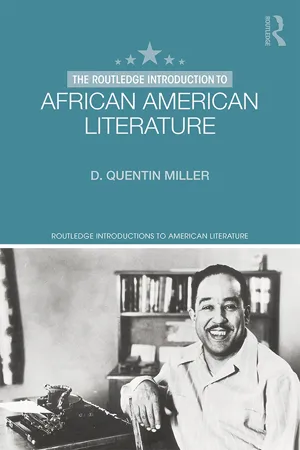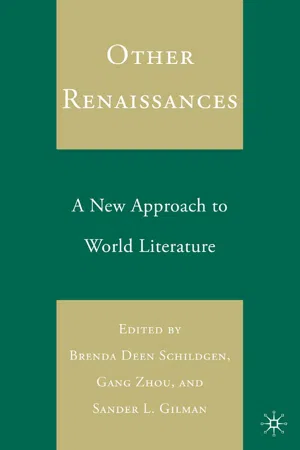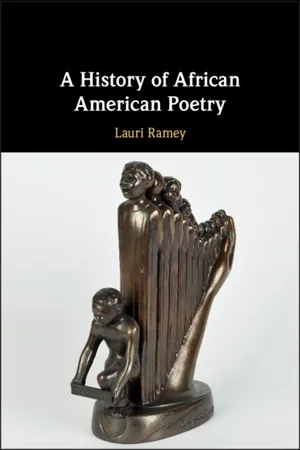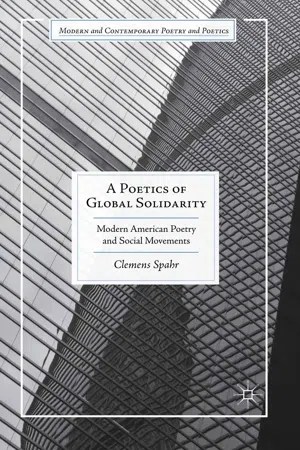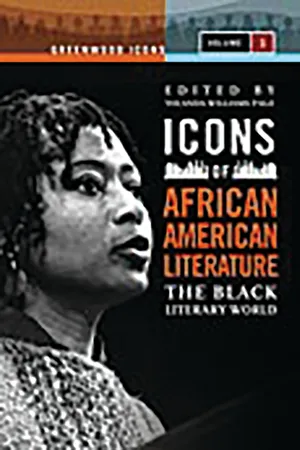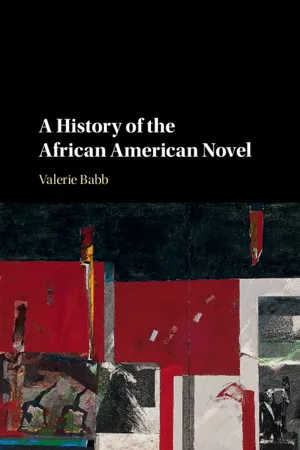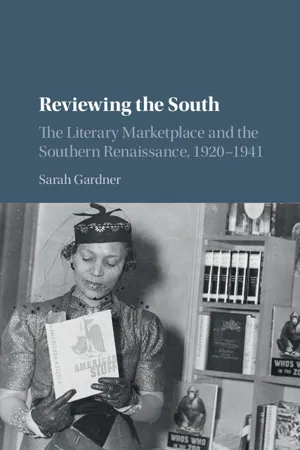History
Harlem Renaissance Literature
The Harlem Renaissance was a cultural, social, and artistic explosion that took place in Harlem, New York, during the 1920s. It was a time when African American literature, art, and music flourished, and it played a significant role in shaping the cultural identity of African Americans. Writers such as Langston Hughes, Zora Neale Hurston, and Claude McKay produced influential works that reflected the experiences and struggles of African Americans.
Written by Perlego with AI-assistance
Related key terms
1 of 5
10 Key excerpts on "Harlem Renaissance Literature"
- D. Quentin Miller(Author)
- 2016(Publication Date)
- Routledge(Publisher)
4 The Era of the Harlem RenaissanceThe period known as the Harlem Renaissance (also called the “New Negro” Renaissance) is mostly associated with the 1920s, though its beginnings can be traced to the years just prior, and some of its spirit continued to exist in the years just after, until the Great Depression brought about a new set of issues that further changed the nature of African American literature. During the 1920s, an unprecedented amount of black writing was published and accepted by the white literary establishment, promising not only a better future for race relations, but, equally importantly, a new sense of black race pride. F. Scott Fitzgerald dubbed the 1920s “The Jazz Age,” and the development of that musical form is central to other African American cultural developments at the time. But although some of the architects and builders of the Renaissance wanted it to be seen as a purely artistic movement, it is evident that the literary tug-of-war of the Reconstruction era between sociopolitical thought and art-for-art’s-sake continued.The word “renaissance” connotes a rebirth, but it also refers to a focused period of extraordinary cultural production. The Harlem Renaissance fulfills both connotations: a new optimism replaced the mood of cultural uncertainty that characterized black America in the late nineteenth and early twentieth centuries, and it manifested itself in a spectacular artistic outburst. There is some debate about whether or not the Harlem Renaissance was a spontaneous outpouring of art or a socially and politically manufactured phenomenon: a conscious attempt to atone for the failures of Reconstruction. David Levering Lewis writes, “The Harlem Renaissance was a somewhat forced phenomenon, a cultural nationalism of the parlor, institutionally encouraged and directed by leaders of the national civil rights establishment for the paramount purpose of improving race relations in a time of extreme national backlash, caused in large part by economic gains won by Afro-Americans during the Great War” (xiii). Nathan Irvin Huggins begins his essential study of the movement with the observation, “It is a rare and intriguing moment when a people decide that they are the instruments of history-making and race-building” (3).- eBook - PDF
- Rachel Farebrother, Miriam Thaggert(Authors)
- 2021(Publication Date)
- Cambridge University Press(Publisher)
Introduction: Revising a Renaissance Rachel Farebrother and Miriam Thaggert In the popular imagination, the Harlem Renaissance is closely associated with the Jazz Age, with rent parties, clubs, cabarets, jazz, and blues. Langston Hughes did much to cement such views of the period, announ- cing in his autobiography The Big Sea (1940) that “it was the period when the Negro was in vogue,” a spectacular cultural boom that came to a sudden halt with the onset of the Depression. 1 In fact, the Harlem Renaissance, or New Negro Movement, was characterized by remarkable diversity that cannot be limited to a linear narrative of boom and bust, and more fiction by black authors was published in the 1930s than in the 1920s. 2 The unprecedented flowering of black cultural production in visual art, literature, dance, and music from the late 1910s to the 1930s encompassed jazz and blues poetry by Sterling A. Brown and Langston Hughes, Zora Neale Hurston’s lyrical renderings of folk culture in the South, George Schuyler’s unusual blending of satire and science fiction in Black No More (1931), militant editorials in the Messenger, and modernist cover designs by such artists as Aaron Douglas and Laura Wheeler Waring. From the outset, participants in the cultural awakening debated whether they were part of a movement and what that movement should be called; they also questioned the location, scope, and political implications of what some writers and intellectuals named the “Negro renaissance.” Alain Locke’s The New Negro (1925), a landmark anthology that brought together some of the most significant cultural figures of the era, including Countee Cullen, Rudolph Fisher, Zora Neale Hurston, Helene Johnson, Jean Toomer, Eric Walrond, and the artist Aaron Douglas, secured its canonical status by reinforcing the cultural nationalist agenda of the Harlem Renaissance. - eBook - PDF
Other Renaissances
A New Approach to World Literature
- B. Schildgen, Z. Gang, S. Gilman, B. Schildgen, Z. Gang, S. Gilman(Authors)
- 2006(Publication Date)
- Palgrave Macmillan(Publisher)
A brief exami- nation of this literary period is crucial in explaining why there are two Chicago Renaissances within half a century. After World War I, Harlem became the focal point of a national movement to highlight and encour- age African-American achievement in the arts and letters. Alain Locke’s New Negro Anthology gave a varied group of texts visibility, purpose, and a name. This period of publishing, conversation, and recognition was made possible by migration of southern African Americans to northern cities; increased access to education; an emerging African-American middle class; the militancy of returning black veterans; the founding of the Urban League, NAACP, African-American women’s clubs and other civil rights organizations; anthropological interest in folklore and music; pseudo-Freudian glorifications of the “primitive”; and white patronage of the black arts, especially jazz. Prominent writers included James Weldon Johnson, W. E. B. DuBois, Jessie Fauset, Claude McKay, Countee Cullen, Langston Hughes, Jean Toomer, and Zora Neale Hurston. Like the rhetoric surrounding the American Renaissance and the first Chicago Renaissance, the act of proclaiming an African-American Renaissance signals cultural independence from another place or entity. Locke titles the first section of his anthology “The Negro Renaissance” and in its opening essay asserts that he is witnessing a movement toward “group expression and self-determination.” This trend is expressed both by African-American intellectuals and by uneducated southern migrants, whose mass departures from the South often force black professionals to follow their clients and congregations North. 12 Locke writes that “the Negro of the Northern centers has reached a stage where tutelage, even of the most interested and well-intentioned sort, must give place to new relationships, where positive self-direction must be reckoned with in ever increasing measure. - eBook - PDF
We Ain’t What We Ought To Be
The Black Freedom Struggle from Emancipation to Obama
- Stephen Tuck(Author)
- 2011(Publication Date)
- Belknap Press(Publisher)
It was a “magnificent assemblage,” said Johnson, again a mixture—as some put it—of “Negrotarians and Niggerati.” The bril-R E N A I S S A N C E I N H A R L E M , D A R K A G E S E L S E W H E R E , 1 9 2 4 – 1 9 4 1 1 7 1 liant young poet Langston Hughes won first prize for The Weary Blues. The publisher Alfred Knopf snapped him up. Years later Johnson re-flected on the awards dinner: “It was intended as the beginning of some-thing and so it was.” 6 The Harlem—or as some called it, the New Ne-gro—Renaissance was born. In fact, the Renaissance was rather less geographically restricted and less original than its names might suggest. Writers came and went, and there were outposts in Washington, Philadelphia, Atlanta, and even Eu-rope. Cooper, Washington, Du Bois, and many others had previously written to critical acclaim. What was new, though, was that the Harlem sponsors of the Renaissance saw black literature as an integral part of the struggle for black equality. As James Weldon Johnson explained in the preface to his 1922 Anthology of Negro Poetry, “No people that has pro-duced great literature . . . has ever been looked upon by the world as dis-tinctly inferior.” What he called the “art approach to the Negro prob-lem” combined various protest ideologies with an added literary twist. 7 Black Americans would gain rights once they had proved their worth. The talented would take the lead. But now, they would fight with the pen. With hindsight, such optimism appears naive, even bizarre. But for Harlem’s literary lords, it seemed perfectly reasonable. Irish nationalism had been marked by a literary renaissance. C. S. Johnson believed litera-ture was “the soft spot . . . in the armor of the nation.” 8 After the any-thing-but-Great War, and taking heed of Freud’s warning that a sup-pressed id led to neurosis, modernist writers worried that white culture tottered on the edge of a nervous breakdown. - eBook - PDF
- Lauri Ramey(Author)
- 2019(Publication Date)
- Cambridge University Press(Publisher)
1, p. 1324. 138 A History of African American Poetry opening pages of The Cambridge Companion to the Harlem Renaissance. 12 Another helpful chronology is found in The Harlem Renaissance: Hub of African-American Culture, 1920–1930, whose title delineates the years of the movement according to author Steven Watson. 13 A very brief chro- nology closes The Harlem Renaissance: A Brief History with Documents, edited by Ferguson, which begins with the start of World War I and ends with the publication in 1939 of “The Negro: ‘New’ or ‘Newer’” in Opportunity, with Locke’s The New Negro in 1925 as a near-midpoint. This volume opens with a concise but useful summary of major figures and publications of the Harlem Renaissance. 14 In The Music of Black Americans, musicologist Eileen Southern also looks ahead to embed the Harlem Renaissance in a larger period of changes taking place from 1920 to 1996. Alternately using the designa- tions of the Black Renaissance and the New Negro Movement, Southern describes the primary manifestation as literary but with explosive impact on all art forms, the re-creation of new kinds of theatrical and musical productions, the breaking down of artistic boundaries, and cross-arts interchange. Southern accepts James Weldon Johnson’s “informal inau- guration” of the period in 1917, with the publication of his Fifty Years and Other Poems commemorating the fifty years since the Emancipation Proclamation. - eBook - PDF
A Poetics of Global Solidarity
Modern American Poetry and Social Movements
- Clemens Spahr(Author)
- 2015(Publication Date)
- Palgrave Macmillan(Publisher)
Even those writers who sought to avoid references to race were perceived as African American writers and thus shared in discussions about the social position of the African American artist. But the institutional context that frequently confronted them with racial discrimination also propelled them beyond concerns with that single question. Many of the writers of the Harlem Renaissance exhibited an enduring commitment to imagining a global poetic subjec- tivity beyond the modern world-system’s mechanisms of exclusion. In this context, it is necessary to take seriously William Maxwell’s claim that “[t]he history of African-American letters cannot be unraveled from the his- tory of American Communism without damage to both” ( New Negro, Old Left 2). Harlem Renaissance writers read their poetry at the same venues, and published in the same journals, as figures of the literary left such as Giovannitti, Rolfe, and Rukeyser. They were involved in political activism from revolutionary movements to women’s struggle against the confining space of the household, “the primary socializing agencies of the world-sys- tem” (Wallerstein, World-Systems Analysis 37). It is therefore necessary to ask what these political and cultural affiliations meant for the poetic production of the time, and how the poetry of the Harlem Renaissance imagined an active role for African American culture in the context of the antisystemic global struggles of the 1920s and 1930s. Barbara Foley has demonstrated that in the post–World War I era, the “term New Negro signified a fighter against both racism and capitalism” (Foley, Spectres of 1919 31). According to Foley, this impulse soon gave way to a cultural nationalism inherent in racial and radical thought at the time, and thus the postwar “New Negro class struggle warrior” deteriorated into the “culture hero of the Harlem Renaissance” in the 1920s (71). - eBook - PDF
Icons of African American Literature
The Black Literary World
- Yolanda Williams Page(Author)
- 2011(Publication Date)
- Greenwood(Publisher)
Being forced to write about one thing or with only one objec- tive was not seen as a liberating experience. Many of the young writers saw the March 21 dinner at the Civic Club as their opportunity to truly express their artistry, but they ultimately found that to be untrue. In order to wrest control of the arts from the powerful hands of the patri- archs, the second-generation writers tried to publish their own periodical, Fire. Functioning as both contributors and editors, Wallace Thurman, Gwendo- lyn Bennett, Langston Hughes, Zora Neale Hurston, and others significantly changed the direction of the Harlem Renaissance. While their periodical only produced one edition, it did allow the authors to break away from the control of Du Bois and others. Their experiment with control allowed them to say that they would write, discuss, and explore whatever they chose. It was after Fire that novels discussing the internal events of the African American and Harlem communities began to surface. From issues of passing to interracial prejudice, the themes appeared; and in some cases, they did so in spite of the disapproval of the elders. However, it was the venturing beyond the conventional themes of race and advancement that really helped to progress the cause. African Americans saw themselves, in their best and at their worst, reflected in the literature they read, and it helped the community to grow. Another text that split the community’s opinion was Claude McKay’s Home to Harlem (1928), which takes its themes from the common man’s world just as his poetry had done. Discussing the world and life of Harlem, McKay penned a tale in which Harlem’s more sordid happenings are shown and al- most praised. Within his novel, McKay’s more common man finds a way to Harlem Renaissance 125 survive and enjoy life while his college-educated counterpart all but implodes with his self-destructive behavior. - eBook - PDF
- Paul Devlin(Author)
- 2021(Publication Date)
- Cambridge University Press(Publisher)
2. Richard Wright, “Blueprint for Negro Writing,” 1937, in Within the Circle: An Anthology of African American Literary Criticism from the Harlem Renaissance to the Present, ed. Angelyn Mitchell (Durham, NC: Duke University Press, 1994), 97. 3. Michael North, The Dialect of Modernism: Race, Language & Twentieth- Century Literature (New York, NY: Oxford University Press, 1994), 11. 4. Geoffrey Jacques, A Change in the Weather: Modernist Imagination, African American Imaginary (Amherst: University of Massachusetts Press, 2009), 6. 5. Brent Hayes Edwards, The Practice of Diaspora: Literature, Translation, and the Rise of Black Internationalism (Cambridge, MA: Harvard University Press, 2003), 3. 6. Houston A. Baker Jr., Modernism and the Harlem Renaissance (Chicago, IL: University of Chicago Press, 1987), xiii, emphasis in original. 7. Mark A. Sanders, Afro-Modernist Aesthetics and the Poetry of Sterling Brown (Athens & London: University of Georgia Press, 1999), 16. 8. Ibid., 17. 228 michael borshuk 9. Zora Neale Hurston, Their Eyes Were Watching God, 1937, in Novels and Stories, ed. Cheryl A. Wall (New York, NY: Library of America, 1995), 180. 10. Ralph Ellison, “Recent Negro Fiction,” New Masses, August 5, 1941, 24. 11. Paul Devlin, “A Literary Archaeology of Reverend Hickman’s Juneteenth Sermon in Ralph Ellison’s Second Novel,” Literature of the Americas 5 (2018), 85. 12. Rudolph Fisher, The Conjure-Man Dies: A Mystery Tale of Dark Harlem, 1932 (Ann Arbor: University of Michigan Press, 1992), 3–4. 13. Ibid., 21. In referring to the similarity of detail between the two novels here, I am again indebted to Paul Devlin who pointed out the curious correspond- ence to me. The Harlem Renaissance 229 chapter 21 Ellison’s Early Writings Barbara Foley Between 1937 and 1952, Ralph Ellison composed several dozen works, both published and unpublished. - eBook - PDF
- Valerie Babb(Author)
- 2017(Publication Date)
- Cambridge University Press(Publisher)
Fiercely proud of all that is entailed in being black, he and his peers – both male and female – have found their black identity and with it an inner strength which rules out forever a return to that traditional brand of race relations that characterized lives of their elders” (4). One cannot help but hear overtones of the New Negro movement in Ebony’s description of the time and thinking, as did Henry Louis Gates that this constituted another black renaissance: The third renaissance was the Black Arts Movement, which extended from the mid-’60s to the early ‘70s. Defining itself against the Harlem Renaissance and deeply rooted in black cultural nationalism, the Black Arts writers Black Arts and Beyond: 1960s–1970s 125 125 imagined themselves as the artistic wing of the Black Power movement. Amiri Baraka, Larry Neal and Sonia Sanchez viewed black art as a matter less of aesthetics than of protest; its function was to serve the political libera- tion of black people from white racism. Erected on a shifting foundation of revolutionary politics, this “renaissance” was the most short-lived of all. By 1975, with the Black Arts Movement dead, black culture seemed to be undergoing a profound identity crisis. (“Black Creativity” 74) Writers of the period might well be called the newest of the New Negroes, but Gates sells short the artistry and influence of their works. While many exhibited a stridency of tone and mission, the attention paid to their polit- ical content often eclipsed consideration of their craft. 3 Certainly phrases such as “whitey,” “the man,” or “ofay,” conveyed outrage, but this body of writing was more than the angry literature of an angry time. Painting the novels with the broad stroke “black nationalist” elided their many inven- tive distinctions. Not always receiving their due are the rigor of craft, the invention of language, the juxtaposing of imagery, the aesthetic reimagin- ing of history, and the resituating of the art–politics debate. - eBook - PDF
Reviewing the South
The Literary Marketplace and the Southern Renaissance, 1920–1941
- Sarah Gardner(Author)
- 2017(Publication Date)
- Cambridge University Press(Publisher)
It culminated with Robert Penn Warren’s Pulitzer Prize in 1947 and William Faulkner’s Nobel Prize for Literature in 1949. Collectively, these writers broke with every literary convention that had defined southern writing since Reconstruction. No longer exclusively defensive and nostalgic, they assumed a critical and distancing perspec- tive on their homeland. They challenged the sentimentalist stories of Thomas Nelson Page and Joel Chandler Harris, the moonlight and mag- nolia romance about the Old South, but they also rejected the explicit racism of Thomas Dixon, whose turn-of-the-century novels The Leopard Spots and The Klansman advocated white supremacy and the rule of the Darwinian elite in the “New South.” Subject matter changed too. Renaissance writers ventured out beyond the plantation big house and into the seamy underbelly of the cotton mills or into “Niggertown.” They wrote about the rapaciousness of white bosses who sexually abused their female African American workers. They wrote about native-born union organizers who threatened to overturn the industrial-capitalist order that had kept workers mired in poverty. They wrote about the lynchings of African American men wrongly accused of crimes. And they wrote about the insuperable odds faced by sharecrop- pers and tenant farmers who struggled to eke out the barest of existences. Yet more than subjectivity and subject changed. Southern Renaissance writers experimented with form as well, adopting modernist literary tech- niques and approaches. Some blurred the lines between genres, mixing poetry and prose, reportage and folklore – sometimes in the same piece. Others engaged in stream of consciousness writing of Joycean proclivi- ties. In both cases, writers sought to erase the distance between reader and character and encourage the reader to participate rather than merely observe. In rejecting the old ways, these writers re-created an image of the South for the twentieth century.
Index pages curate the most relevant extracts from our library of academic textbooks. They’ve been created using an in-house natural language model (NLM), each adding context and meaning to key research topics.
